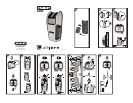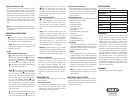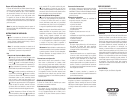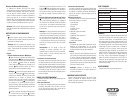
Stanley Stud Sensor 200
The Stud Sensor 200 uses electronic signals
to locate the center of studs, joists or live AC
wires through drywall or other common building
materials. Once the center of a stud has been
detected in one pass across the surface, the Stud
Sensor 200 gives a visual display and sounds an
audible tone. A marking channel allows you to
easily note the stud center and edges on the
wall.
Note: Read all instructions prior to operating the
Stud Sensor 200 and DO NOT remove any labels
from the tool.
OPERATING INSTRUCTIONS
Battery
1
Open door on back of unit and connect a
9 volt battery (not included) to clip. Put battery
back into case and close back battery door.
Note: Recommend to replace a new 9 volt
battery when low battery - “Low Battery” will
appear on the LCD.
Usage
Detecting Wood / Metal Studs
2
Hold the Stud Sensor 200 flat against the
surface, making firm contact.
3
Press in and
hold the activation button. A series of tones
will sound.
4
When the unit is calibrated
the “Ready” icon will appear on the LCD.
5
Keep holding the activation button during
all of the following procedures.
Note:
3
The unit cannot be moved before
calibration is complete.
2
While calibrating,
the Stud Sensor 200 must not be placed
directly over a stud, dense material such as
metal, or over a wet or newly painted area,
or it will not properly calibrate.
11
If all
segments of the LCD flash on and off when
the activation button is pressed, move the
Stud Sensor 200 to a different location and
try again. Releasing the activation button will
turn off the sensor.
6
Slide the Stud Sensor 200 slowly across
the surface in a straight line.
9
As it detects
a stud, the Stud Sensor 200 will display the
relative position of the stud on the screen.
6
When it detects the stud center, the
“Center” icon will appear on the LCD and
an audible tone will sound. Use the marking
channel located at the top of the unit to mark
the stud center.
Detecting Live AC Wires
10
The live wire red LED will illuminate, the
“AC” icon will appear on the LCD, and the
Stud Sensor 200 sounds an audible tone,
warning when in the proximity (typically
within 4” to 18” along the surface) from a live
wire.
Note: Static electrical charges that can
develop on drywall and other surfaces will
spread the voltage detection area many
inches on each side of the actual electrical
wire. To aid in locating the wire position,
scan holding the unit ½” away from the
wall surface or place your other hand on the
surface approximately 12” from sensor.
Warning: Shielded wires or wires in metal
conduits, casings, metallized walls or thick,
dense walls will not be detected. Always turn
off AC power when working near wiring.
Cautions on Operating
You should always use caution when nailing,
cutting and drilling in walls, ceilings and
floor that may contain wiring and pipes near
the surface. Always remember that studs
or joists are normally spaced 16 inches or
24 inches apart and are 1½ inches in width. To
avoid surprises, be aware that anything closer
together or of a different width may not be a
stud.
OPERATING TIPS
The Stud Sensor 200 is designed for use only on
interior surfaces.
Prevent Interference
To ensure best performance from the Stud
Sensor 200, keep your free hand at least
6 inches away from the unit and wall surface
while testing or scanning surfaces.
Conventional Construction
Doors and windows are commonly constructed
with additional studs and headers for added
stability. The Stud Sensor 200 detects the edge
of these double studs and solid headers as a
single, wide stud.
Surface Differences
The Stud Sensor 200 will scan through common
building materials, Including:
•Gypsum drywall
•Plywood sheathing
•Hardwood floors
•Linoleum over wood
•Wallpaper
The scanner cannot scan through:
•Carpeting
•Foil faced materials
•Ceramic tile
•Cement or concrete
•Metal & plaster walls
Wallpaper
There will be no difference in the function of
the Stud Sensor 200 on surfaces covered with
wallpaper or fabric unless the coverings used
contain metallic foil or fibers.
Ceilings
When dealing with a rough surface such as
a sprayed ceiling, utilize a piece of cardboard
when scanning the surface. Run through the
calibration technique described earlier with
the piece of cardboard too, to assure best
performance of the unit. Also, it is particularly
important in this application to remember to
keep your free hand away from the unit.
Note: The thickness, density and moisture
content of the surface material will affect the
sensing depth.
IMPORTANT SAFETY NOTICE
Insure proper detection of live wires. Always
hold the Stud Sensor 200 in the handle area only.
Grasp between fingers and thumb while making
contact with your palm.
SPECIFICATIONS
(At 35-55% relative humidity)
Battery
9 volt (not included)
Depth Range
Wood or Metal Studs
Up to ¾” (19 mm) through drywall
Live AC Wires (120 volts AC)
Up to 2” (50 mm) through drywall
Accuracy - Stud Center
Wood
±1/8” (3 mm)
Metal
±1/4” (6 mm)
Operating Temperature
+32°F to +120°F (-0°C to +49°C)
Surface Temperature
-4°F to +150°F (-20°C to +66°C)
WARRANTY
Stanley Tools warrants the Stud Sensor 200
against defects in material and workmanship
for one year from the date of purchase. Stanley’s
liability under this warranty is limited the
replacement of the unit. Any attempt to repair
the product by other than factory authorized
personnel will void this warranty. Calibration,
batteries and maintenance are the responsibility
of the user. Where permitted by law, Stanley is
not responsible for incidental or consequential
damages. Agents of Stanley cannot change
this warranty. Stanley is not responsible for
damage resulting from wear, abuse or alteration
of this product. The user is expected to follow
ALL operating instructions. This warranty may
provide you with additional rights that vary by
state, province or nation.
WARNING:
Protect Your Eyes, Wear Safety Goggles.
©2012 STANLEY TOOLS
www.STANLEYTOOLS.com
701 East Joppa Road
Towson, Maryland 21286






